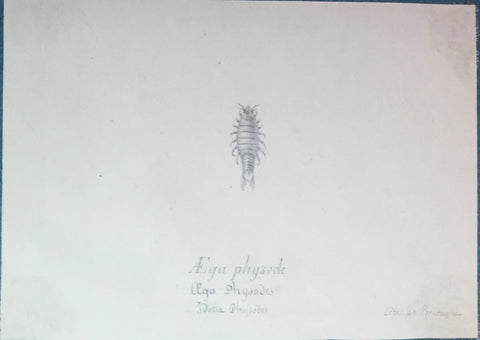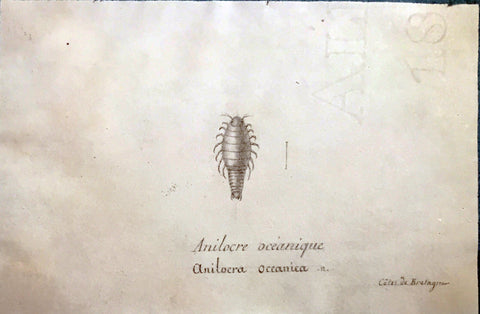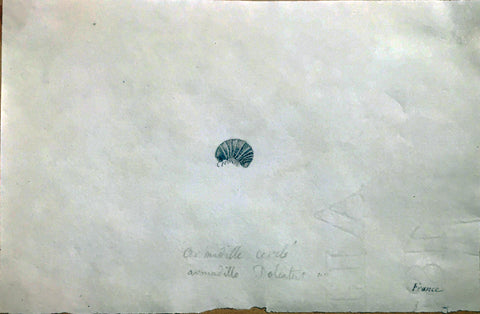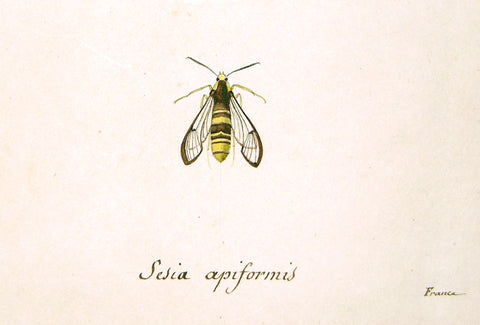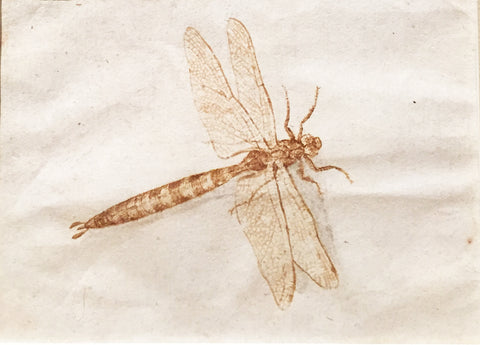
ATTRIBUTED TO JACQUES DE GHEYN II (DUTCH, 1576-1632), Study of a Dragonfly
Attributed to Jacques de Gheyn II (DUTCH, 1576-1632)
Study of a Dragonfly
Pen and brown ink on off-white laid paper
Paper watermarked with an armorial cartouche with Strasbourg bent and letters
Paper size: 3 5/8 x 5 5/8 in.
Frame size: 8 ¼ x 9 ½ in.
Jacques de Gheyn II was one of the greatest Dutch draftsmen before Rembrandt. He pioneered Dutch naturalism, characterized by a keen interest in natural objects, particularly small specimens such as insects and shellfish.
De Gheyn was born in Antwerp and received his early training from his father, Jacob de Gheyn I, a glass painter, engraver, and draftsman. In 1585, he moved to Haarlem, where he studied under Hendrik Goltzius for five years. He then moved to Leiden in the mid-1590s. His work caught the attention of wealthy patrons, including Maurice of Nassau, Prince of Orange.
De Gheyn was a wealthy amateur and had connections to prestigious social circles who were avid natural history collectors. Interest in specimen insects was boosted by technological advancements such as Drebbel’s microscope, constructed around 1620. His neighbor, the humanist Constantijn Huygens, provided the artist access to the Drebbel microscope almost immediately after its creation. Writing with wonder to the artist, “It really is as if you stand before a new theatre of nature, or you are on a different planet.” Huygens tried to persuade his friend, Jacques de Gheyn, to create a series of microscopic studies of God’s Creation. De Gheyn started the project but did not complete it due to his death in 1629. This artwork showcases De Gheyn’s incredible technical prowess as a virtuosic draftsman. He employed a combination of bold and gentle lines to represent the subject. and his connection to prestigious social circles were avid natural history collectors. Interest in specimen insects was bolstered by technological advancements such as Drebbel’s microscope (lunette), constructed around 1620. His neighbor, the humanist Constantijn Huygens, provided the artist access to the Drebbel microscope almost immediately after its creation. Writing with wonder to the artist, “It really is as if you stand before a new theatre of nature, or you are on a different planet.” Huygens tried to convince his friend, Jacques de Gheyn, to create a series of microscopic studies of God’s Creation. De Gheyn began the project but was never completed due to the artist’s death in 1629. Here, De Gheyn displays incredible technical prowess; he was a virtuosic draftsman. De Gheyn used a combination of bold and gentle lines to represent the subject.
Study of a Dragonfly
Pen and brown ink on off-white laid paper
Paper watermarked with an armorial cartouche with Strasbourg bent and letters
Paper size: 3 5/8 x 5 5/8 in.
Frame size: 8 ¼ x 9 ½ in.
Jacques de Gheyn II was one of the greatest Dutch draftsmen before Rembrandt. He pioneered Dutch naturalism, characterized by a keen interest in natural objects, particularly small specimens such as insects and shellfish.
De Gheyn was born in Antwerp and received his early training from his father, Jacob de Gheyn I, a glass painter, engraver, and draftsman. In 1585, he moved to Haarlem, where he studied under Hendrik Goltzius for five years. He then moved to Leiden in the mid-1590s. His work caught the attention of wealthy patrons, including Maurice of Nassau, Prince of Orange.
De Gheyn was a wealthy amateur and had connections to prestigious social circles who were avid natural history collectors. Interest in specimen insects was boosted by technological advancements such as Drebbel’s microscope, constructed around 1620. His neighbor, the humanist Constantijn Huygens, provided the artist access to the Drebbel microscope almost immediately after its creation. Writing with wonder to the artist, “It really is as if you stand before a new theatre of nature, or you are on a different planet.” Huygens tried to persuade his friend, Jacques de Gheyn, to create a series of microscopic studies of God’s Creation. De Gheyn started the project but did not complete it due to his death in 1629. This artwork showcases De Gheyn’s incredible technical prowess as a virtuosic draftsman. He employed a combination of bold and gentle lines to represent the subject. and his connection to prestigious social circles were avid natural history collectors. Interest in specimen insects was bolstered by technological advancements such as Drebbel’s microscope (lunette), constructed around 1620. His neighbor, the humanist Constantijn Huygens, provided the artist access to the Drebbel microscope almost immediately after its creation. Writing with wonder to the artist, “It really is as if you stand before a new theatre of nature, or you are on a different planet.” Huygens tried to convince his friend, Jacques de Gheyn, to create a series of microscopic studies of God’s Creation. De Gheyn began the project but was never completed due to the artist’s death in 1629. Here, De Gheyn displays incredible technical prowess; he was a virtuosic draftsman. De Gheyn used a combination of bold and gentle lines to represent the subject.
We Also Recommend

